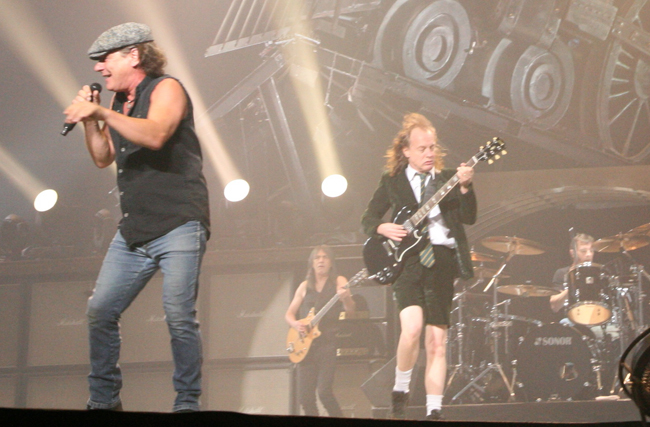
Originally published on metropolis.co.jp on March 2010

Hell Ain’t a Bad Place to be, and neither is Saitama tonight with the biggest rock band on the planet in town. Surrounded by large open spaces and served by two stations on different main lines into central Tokyo, Saitama Super Arena is custom-built for mass live events like this. It also houses that most incongruous of phenomena: a lame-duck rock museum, dedicated to the second most talented Beatle, which is due to close this September.
But tonight is not about history, even though the hard rock of AC/DC may have an antique patina—as evinced by Brian Johnson’s bluesy, nicotine-stained voice and Angus Young’s Chuck-Berry-style duck-walks and clipped riffs on openers “Rock and Roll Train” and “Back in Black.” No, the Australian five-piece, four of whose members were born in the UK, is a going concern and not about to rest on its laurels.
But while John Lennon’s appeal seems to have run out of steam in this part of the world, AC/DC is gifted with the common touch that allows them to effortlessly connect with the masses. Their stage set tonight includes an enormous steam train, complete with devil horns, which apparently strikes a chord with the large proportion of train spotters in the audience (compared to “Yoko Ono’s Folly,” the nearby Saitama Railway Museum is a runaway success). It also serves as an enormous phallic metaphor, especially later in the show during “Rosie,” when a giant blow-up doll of the eponymous slapper surmounts the steaming behemoth.
Still, the double-entendres and implied sexuality, just like the comic seaside postcards of Donald McGill that graced many a British seaside resort round about the time the Young brothers left their native Scotland for Australia in 1963, only serves to create a cozy, family atmosphere. Something similar can be said about the thousands of pairs of glowing devil horns worn by the audience. Far from creating a Satanic sense of menace, they act rather like Xmas decorations when the lights are down. The overall vibe of the show is of an extremely large family gathering overseen by a couple of mischievous uncles determined to get the good times rolling, with Angus Young’s incredible guitar pyrotechnics as the main party piece.
Backed by the engine-room of Phil Rudd’s drumming, Cliff William’s bass, and Malcolm Young’s rhythm guitar, the two front men roll up their proverbial sleeves and get stuck in. But while Johnson’s muscular, rasping voice sticks manfully to the script, taking few real risks, Angus Young constantly launches himself into spasmodic, improvised, high-octane guitar breaks, with passion and razor-sharp synapses his only guide. Regardless of the entertaining schtick of the schoolboy uniform, Young emits a palpable sense of juvenile excitement and energy with his adventurous playing. A workmanlike version of “Dirty Deeds Done Dead Cheap” is given an extra flourish at the death as Young eats up the fret board just for the hell of it, while the chugging rock of “Black Ice” sees the Young brothers slashing riffs at each other in an escalating whirlwind of sonic abuse.
Just when the sublimity of it all threatens to overpower, comic relief is never far away. “This next song’s about a DIRRRRTY woman,” Johnson says by way of intro to the skanky blues crawl of “The Jack,” a song about venereal disease. During the tongue-in-cheek performance, the cameras work hard picking out the “hottest” chicks in the audience and putting them up on the big screen. With Johnson singing “she’s got the jack,” the auditorium cheers and laughs as we get a motley selection of shy OLs and timid schoolgirls, some of them in face masks. But the element of comedy doesn’t stop Angus pumping out yet another searing guitar solo to take your breath away.
Next we get a true Spinal Tap moment as a massive bell inscribed with the band’s logo descends from the sky and Johnson, Quasimodo-like, swings from it. This introduces the Sabbathesque riffery of “Hells Bells.” The next few songs, including the punkish, percussive “Shoot to Thrill” and the relentless riff of “War Machine,” stay with the harder, darker feel, before returning to the party mood of “You Shook Me.” Then we get early standard “TNT,” followed by the rock ‘n’ roll vaudeville of “Rosie” with its steam-engine-straddling inflatable sex goddess.
After 90 minutes of this, most bands would be spent forces, but as AC/DC kick into closer “Let There Be Rock,” Angus Young, long since stripped to his schoolboy shorts, is a ball of spinning, demonic energy, lashing chords and laying solos on brother Malcolm’s riffs. It starts to sound like the group have three guitarists rather than two—then four, then five, and then, suddenly, Angus is all alone and spends the next few minutes giving an incredible, one-man demonstration of just how expressive six strings wired to the national grid can be.
For an encore, the whole band returns to give us a rousing “Highway to Hell,” then we are sent home with “For Those About to Rock” ringing in our ears. Because of its title, this last number sits oddly at the end of the set list, but perhaps it just shows how meaningless time is in AC/DC’s eternal rock universe.







